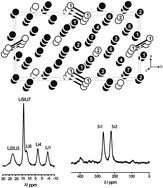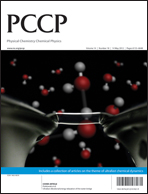Local environments and lithium ion dynamics in the binary lithium silicides Li15Si4, Li13Si4, and Li7Si3 have been characterized by detailed variable temperature static and magic-angle spinning (MAS) NMR spectroscopic experiments. In the 6Li MAS-NMR spectra, individual lithium sites are generally well-resolved at temperatures below 200 K, whereas at higher temperatures partial or complete site averaging is observed on the ms timescale. The NMR spectra also serve to monitor the phase transitions occurring in Li7Si3 and Li13Si4 at 235 K and 146 K, respectively. The observed lithium isotropic shift ranges of up to approximately 50 ppm indicate a significant amount of electronic charge stored on the lithium species, consistent with the expectation of the extended Zintl–Klemm–Busmann concept for the electronic structure of these materials. The 29Si MAS-NMR spectra obtained on isotopically enriched samples, aided by double-quantum spectroscopy, are well suited for differentiating between the individual types of silicon sites within the silicon frameworks, and in Li13Si4 their identification aids in the assignment of individual lithium sites via29Si{7Li} cross-polarization/heteronuclear correlation NMR. Variable temperature static 7Li NMR spectra reveal motional narrowing effects, illustrating high lithium ionic mobilities in all of these compounds. Differences in the mobilities of individual lithium sites can be resolved by temperature dependent 6Li MAS-NMR as well as 6Li{7Li} rotational echo double resonance (REDOR) spectroscopy. For the compound Li15Si4 the lithium mobility appears to be strongly geometrically restricted, which may result in a significant impediment for the use of Li–Si anodes for high-performance batteries. A comparison of all the 6Li and 7Li NMR spectroscopic data obtained for the three different lithium silicides and of Li12Si7 previously studied suggests that lithium ions in the vicinity of silicon clusters or dimers have generally higher mobilities than those interacting with monomeric silicon atoms.

You have access to this article
 Please wait while we load your content...
Something went wrong. Try again?
Please wait while we load your content...
Something went wrong. Try again?


 Please wait while we load your content...
Please wait while we load your content...